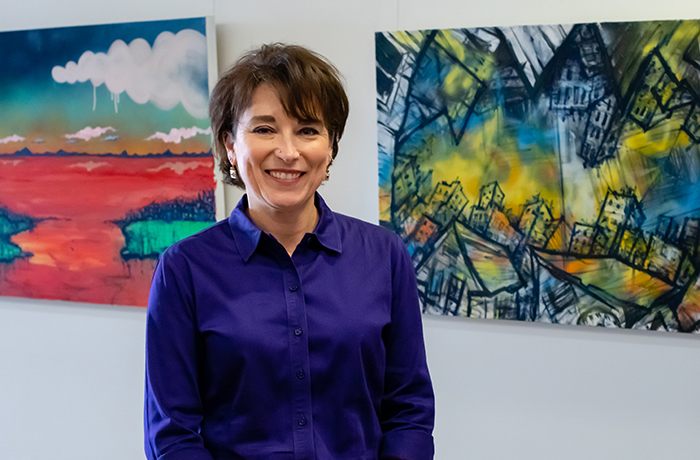
Faculty Spotlight: Cynthia Standley, PhD

Cynthia Standley, PhD, always knew she wanted to wear a white coat, she just didn’t know if it would be for science or art.
Dr. Standley, program director of the Art in Medicine program and a founding faculty member at the University of Arizona College of Medicine – Phoenix, has been a medical educator for more than 25 years.
“I love teaching physiology and neuroscience to medical and health professional students,” Dr. Standley said. “Every time I meet a new class, I find myself continuing to learn things and I find my time with them uplifting and inspiring. I really enjoy the active learning and teaching in the model of the flipped classroom. That’s where you can really see the light bulbs turn on.”
Dr. Standley did not always see herself as a teacher. At one point, she wanted to become a scientific illustrator, but instead, opted for a science route and kept art on the side.
“I have always been interested in the brain. I was an aerobics instructor in college and one of my co-workers was a medical student at Wayne State University and I happened to mention to her that I loved learning about the brain,” Dr. Standley said. “She connected me with a neurophysiologist who then became my mentor and next thing you know, I graduated with a PhD in Physiology.”
Dr. Standley received her bachelor’s degree in biology and PhD in physiology from Wayne State University in Detroit, Michigan. Her first faculty appointment was at the Detroit Medical Center, but ultimately, she moved to Phoenix to become part of the inaugural faculty at the Arizona College of Osteopathic Medicine in Glendale. She was there for 10 years before she helped open the School of Osteopathic Medicine in Mesa. Eventually, she found her way to the UA College of Medicine – Phoenix in 2008.
Dr. Standley started at the college as a research professor with a lab in the Department of Basic Medical Sciences. Her research was in the area of pre-eclampsia, seizures and magnesium sulfate. She closed her lab a few years ago to focus on medical education research. Her current work is funded by the Team-Based Learning Collaborative.
In 2014, Dr. Standley started the Art in Medicine program under the Department of Bioethics and Medical Humanism to help medical students sharpen their skills in observation and description, foster critical thinking and improve communication skills. In the program, medical students are challenged to explore the range of human emotion and perception of the world as conveyed visually.
“Medical students are taught to recognize patterns using diagnostic algorithms, to think very critically, with an eye toward details,” Dr. Standley said. “Art in Medicine expands on this and provides them with opportunities to think more openly. Instead of listening with an ear toward a preconceived conclusion, we encourage listening for understanding, looking for the details that should capture their attention. This way, we are promoting divergent, out-of-the-box thinking and equipping our students to make meaningful connections between disparate fragments. With innovative practices, we can improve the health of the patients and ultimately, promote more humanistic care.”
Several years ago, Dr. Standley attended an Educator’s Night at the Phoenix Art Museum where she met the museum’s director of education. They brainstormed a way to involve medical students in viewing art that could relate to what they were learning in their clinical skills course. The program has been so successful that they now offer six evening programs a year for students, faculty and staff at the museum.
Through partnerships with museums, students are offered programs in structured observation of artworks and discussion of fine arts concepts with the goal of improving their visual diagnostic skills and communication skills. Within the Art in Medicine program, Dr. Standley, in collaboration with Gary Glazner of the Alzheimer’s Poetry Project out of Brooklyn, NY, started the college’s Creativity in Elder Care program, which trains medical students in the use of creative expression to improve care in patients with dementia.
“I am really proud of the Creativity in Elder Care Program,” Dr. Standley said. “It’s been great to have this program recognized by the Arizona Commission on the Arts. So, while I didn’t go to school for art, it is awesome that I can now bring art into my daily life at work.”
About the College
Founded in 2007, the University of Arizona College of Medicine – Phoenix inspires and trains exemplary physicians, scientists and leaders to advance its core missions in education, research, clinical care and service to communities across Arizona. The college’s strength lies in our collaborations and partnerships with clinical affiliates, community organizations and industry sponsors. With our primary affiliate, Banner Health, we are recognized as the premier academic medical center in Phoenix. As an anchor institution of the Phoenix Bioscience Core, the college is home to signature research programs in neurosciences, cardiopulmonary diseases, immunology, informatics and metabolism. These focus areas uniquely position us to drive biomedical research and bolster economic development in the region.
As an urban institution with strong roots in rural and tribal health, the college has graduated more than 1,000 physicians and matriculates 130 students each year. Greater than 60% of matriculating students are from Arizona and many continue training at our GME sponsored residency programs, ultimately pursuing local academic and community-based opportunities. While our traditional four-year program continues to thrive, we will launch our recently approved accelerated three-year medical student curriculum with exclusive focus on primary care. This program is designed to further enhance workforce retention needs across Arizona.
The college has embarked on our strategic plan for 2025 to 2030. Learn more.